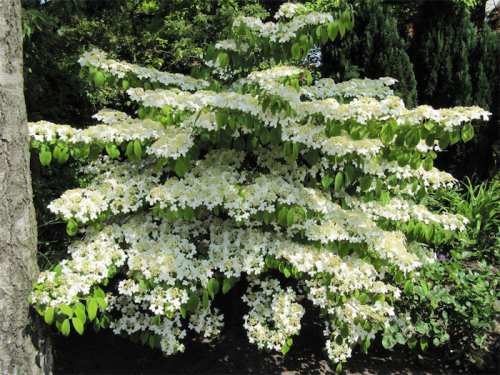
AS garden sizes in new housing developments seem to get smaller, there’s an increasing demand for smaller evergreen shrubs suitable for these sorts of blocks.

In new suburbs, such as Casey, the average block size is now 440 square metres. And in the latest suburb of Lawson, some blocks are just 270 square metres – a far cry from the standard old “quarter-acre” blocks of about 880 square metres. After a home is built, it seems there’s just enough space for two terracotta pots either side of the front door to grow parsley!
This week, starting with the Viburnum family, I am looking at plants for gardens where there is still space to grow some of the delightful deciduous shrubs that grandma used to grow.
There are about 210 varieties of Viburnums, both evergreen and deciduous. The more interesting are the deciduous varieties, most of which have white flowers that in many are followed by attractive fruit and wonderful leaf colour in autumn.
First up is Viburnum carlesi, originating from Korea and one of the most popular varieties. The buds start off pink before changing to pure white with a sweet daphne-like fragrance by early spring.
The most attractive spring show is V. plicatum mariesii, when the flattened lacecap flowers, almost like hydrangeas, cover the bush. From a distance it looks as if it is covered in snow.
V. opulus “Roseum”, as the name suggests, has pink-tinged flowers. This is often referred to as the Snowball Bush because of the distinctive balls of white flowers that look like snowballs.
However V. plicatum tomentosum and V. macrocephalum are also referred to as the Snowball Bush. Irrespective of the confusion, they are all wonderful in early to mid-spring.

When viewed in garden centres at this time they will be covered in buds, as are most spring-flowering, deciduous shrubs. So whether it’s new plants or they’re already in the garden, there is definitely no pruning at this time (the exception being to take out any obvious dead branches or crossing-over branches that are rubbing against each other).
Now is definitely the ideal time to plant to enjoy their spring beauty. Remember to keep all chemical fertilisers well away from the roots as they can seriously cause damage.
After planting, water in with a seaweed solution, which will specifically encourage new, strong roots.
A READER asked about limes, wondering if it was okay to let them turn yellow on the tree. I discussed this with Engall’s Nursery of Dural, specialist growers of grafted citrus since 1946 of whom I have dealt with for more than 30 years, who advised it was best not to allow the fruit to turn yellow and pick them green for the right juice.
ELSEWHERE, I read some local gardening advice that Lilli Pilli would make an ideal hedge in Canberra. However, I recommend it best not to plant Lilli Pilli as the first good frost will wipe them out. On the other hand, they’re great for the coast.
Jottings…
- Sand back wooden tool handles and rub them with linseed oil.
- Plant strawberry runners now, make sure they are “Certified Virus Free” stock.
- Check the labels for size of Viburnum.
- We’ve passed the shortest day of the year (June 21) and it’s all downhill now to spring. What happened to winter?
Who can be trusted?
In a world of spin and confusion, there’s never been a more important time to support independent journalism in Canberra.
If you trust our work online and want to enforce the power of independent voices, I invite you to make a small contribution.
Every dollar of support is invested back into our journalism to help keep citynews.com.au strong and free.
Thank you,
Ian Meikle, editor




Leave a Reply